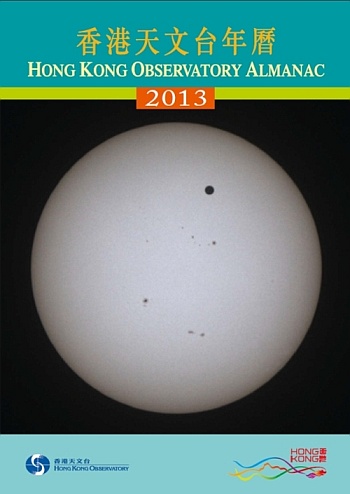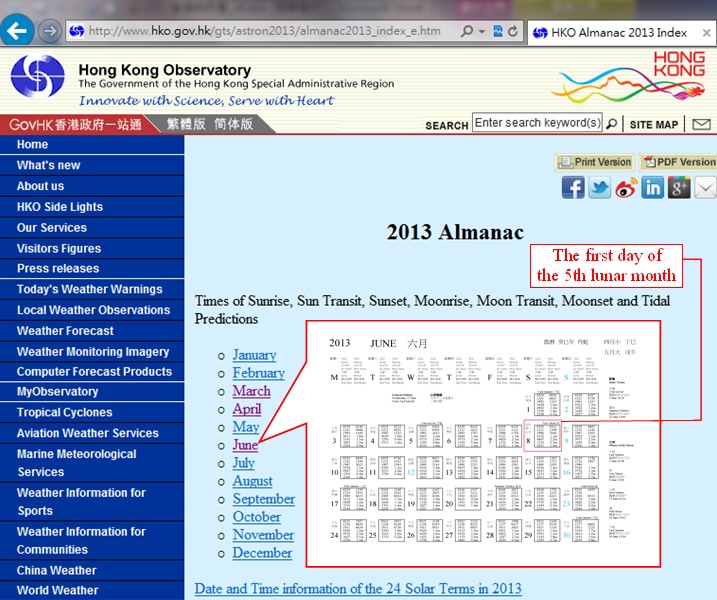Which day is the Tuen Ng Festival for this year (2013)?
3 May 2013
Which day in the Gregorian calendar is the first day of the 5th lunar month this year (2013)? This question has aroused public concern and discussion (http://www.ettoday.net/news/20121120/129516.htm). According to the "Hong Kong Observatory (HKO) Almanac 2013" [Figure 1], using the high-precision astronomical data of the HM Nautical Almanac Office, U.K. and the U.S. Navy Observatory, the first day of the 5th lunar month in 2013 will be on 8 June in the Gregorian calendar, same as that of the official almanac of Mainland China. However, some common Chinese folk calendars fix that day to be 9 June. Because of this difference, there appears to be two different Gregorian dates of the Tuen Ng Festival (the 5th day of the 5th lunar month) in 2013.
In fact, such discrepancy is not uncommon. Table 1 shows that there will be three more similar situations in the next 20 years. In particular, there are two different dates for the Lunar New Year Day in 2030!

Table 1Comparison of Gregorian-Lunar calendar conversion of HKO Almanac and some Chinese folk calendars.
What are the reasons behind the discrepancies? Let us first understand how the first day of a lunar month is determined from the astronomical point of view.
Each month in the lunar calendar starts with a "New Moon", which occurs when the Moon and the Sun move to the same longitude on the ecliptic[1], [2]. Different computed dates in different calendars come about due to two main reasons: (a) outdated astronomical computation; and (b) change in the standard time adopted.
First of all, astronomical computation has become more and more precise with the advance in science and technology. Official authorities will make use of the latest astronomical data and computation methodology to re-calculate and revise the calendars from time to time. The Hong Kong Observatory and the Zijinshan Astronomical Observatory of Mainland China will revise the official calendars whenever there are updated information and decisions issued by the International Astronomical Union and the Jet Propulsion Laboratory in the US. On the other hand, some of the Chinese folk calendars are compiled based on outdated astronomical data and methodology or duplicating the data from old versions of official calendars. In case when the "New Moon" occurs very close to midnight, it is possible to have different start times for the first day of lunar month based on different astronomical data and computation methodologies. For example, the "New Moon" of the 5th lunar month this year (2013) will occur at 23:56 Hong Kong Standard Time (HKT) on 8 June based on the latest astronomical data and computation methodology. If outdated data and computation methodology are used, the "New Moon" may appear after 00:00 (HKT) on 9 June and the first day of the 5th lunar month will then occur on 9 June. Table 2 shows that all the times for the "New Moons" of the four dates mentioned in Table 1 will occur near midnight based on the latest astronomical data and computation methodology.

Table 2The Gregorian calendar dates and Hong Kong Standard Times of the New Moons
for the first days of the lunar months listed in Table 1.
Secondly, even though the same astronomical data and computation methodology are used, the results may still be different if different standard times are adopted. In late Qing and early Republic period, the 116.383 degree East (longitude of Beijing) of apparent solar time[3] was used as time standard . However, a unified time zone, which is 120 degree East of longitude of apparent solar time, was adopted as the standard time for Mainland China soon after the establishment of the People's Republic of China. The times for "New Moons" and the "Solar Terms" of the calendar was then converted to the Coordinated Universal Time (UTC) plus eight hours. It is noted that the difference in these two standard times adopted may lead to a difference of about 14.468 minutes for defining the beginning of a day. Therefore, adopting different standard times could generate different results in compiling the calendar even though the same astronomical data and computation methodology are used. For example, the first day of the 1st lunar month in 1916 would be on 4 February (the "New Moon" occurred at 00:05 on 4 February) if the current standard time is used, but it was fixed on 3 February (the "New Moon" occurred at 23:51 on 3 February) based on the standard time used at that time.
There are many publications of Chinese folk calendars in the market. Most of them have not specified the authors and source of data. It is therefore rather difficult to trace the source of astronomical data and computation methodology as well as the standard time adopted. As a difference in one minute may cause the difference of one day in Gregorian-Lunar calendar conversion, it is not surprising to find discrepancies between the latest official calendars and folk calendars. Please double-check the Observatory's Almanac if in doubt (http://www.hko.gov.hk/gts/astron2013/almanac2013_index_e.htm) [Figure 2].
Wai-Kwong Wong, Dickson Lau
References:
[1] http://en.wikipedia.org/wiki/Ecliptic_longitude
[2] The Chinese Agricultural Calendar (Nongli) http://www.hko.gov.hk/gts/time/calendarinfo.htm
[3] http://www.hko.gov.hk/gts/time/basicterms-UTandGMT.htm

Figure 1Hong Kong Observatory Almanac.

Figure 2The electronic version of the Hong Kong Observatory Almanac.
In fact, such discrepancy is not uncommon. Table 1 shows that there will be three more similar situations in the next 20 years. In particular, there are two different dates for the Lunar New Year Day in 2030!

Table 1Comparison of Gregorian-Lunar calendar conversion of HKO Almanac and some Chinese folk calendars.
What are the reasons behind the discrepancies? Let us first understand how the first day of a lunar month is determined from the astronomical point of view.
Each month in the lunar calendar starts with a "New Moon", which occurs when the Moon and the Sun move to the same longitude on the ecliptic[1], [2]. Different computed dates in different calendars come about due to two main reasons: (a) outdated astronomical computation; and (b) change in the standard time adopted.
First of all, astronomical computation has become more and more precise with the advance in science and technology. Official authorities will make use of the latest astronomical data and computation methodology to re-calculate and revise the calendars from time to time. The Hong Kong Observatory and the Zijinshan Astronomical Observatory of Mainland China will revise the official calendars whenever there are updated information and decisions issued by the International Astronomical Union and the Jet Propulsion Laboratory in the US. On the other hand, some of the Chinese folk calendars are compiled based on outdated astronomical data and methodology or duplicating the data from old versions of official calendars. In case when the "New Moon" occurs very close to midnight, it is possible to have different start times for the first day of lunar month based on different astronomical data and computation methodologies. For example, the "New Moon" of the 5th lunar month this year (2013) will occur at 23:56 Hong Kong Standard Time (HKT) on 8 June based on the latest astronomical data and computation methodology. If outdated data and computation methodology are used, the "New Moon" may appear after 00:00 (HKT) on 9 June and the first day of the 5th lunar month will then occur on 9 June. Table 2 shows that all the times for the "New Moons" of the four dates mentioned in Table 1 will occur near midnight based on the latest astronomical data and computation methodology.

Table 2The Gregorian calendar dates and Hong Kong Standard Times of the New Moons
for the first days of the lunar months listed in Table 1.
Secondly, even though the same astronomical data and computation methodology are used, the results may still be different if different standard times are adopted. In late Qing and early Republic period, the 116.383 degree East (longitude of Beijing) of apparent solar time[3] was used as time standard . However, a unified time zone, which is 120 degree East of longitude of apparent solar time, was adopted as the standard time for Mainland China soon after the establishment of the People's Republic of China. The times for "New Moons" and the "Solar Terms" of the calendar was then converted to the Coordinated Universal Time (UTC) plus eight hours. It is noted that the difference in these two standard times adopted may lead to a difference of about 14.468 minutes for defining the beginning of a day. Therefore, adopting different standard times could generate different results in compiling the calendar even though the same astronomical data and computation methodology are used. For example, the first day of the 1st lunar month in 1916 would be on 4 February (the "New Moon" occurred at 00:05 on 4 February) if the current standard time is used, but it was fixed on 3 February (the "New Moon" occurred at 23:51 on 3 February) based on the standard time used at that time.
There are many publications of Chinese folk calendars in the market. Most of them have not specified the authors and source of data. It is therefore rather difficult to trace the source of astronomical data and computation methodology as well as the standard time adopted. As a difference in one minute may cause the difference of one day in Gregorian-Lunar calendar conversion, it is not surprising to find discrepancies between the latest official calendars and folk calendars. Please double-check the Observatory's Almanac if in doubt (http://www.hko.gov.hk/gts/astron2013/almanac2013_index_e.htm) [Figure 2].
Wai-Kwong Wong, Dickson Lau
References:
[1] http://en.wikipedia.org/wiki/Ecliptic_longitude
[2] The Chinese Agricultural Calendar (Nongli) http://www.hko.gov.hk/gts/time/calendarinfo.htm
[3] http://www.hko.gov.hk/gts/time/basicterms-UTandGMT.htm

Figure 1Hong Kong Observatory Almanac.

Figure 2The electronic version of the Hong Kong Observatory Almanac.